air conditioning ISUZU TROOPER 1998 Service Owner's Guide
[x] Cancel search | Manufacturer: ISUZU, Model Year: 1998, Model line: TROOPER, Model: ISUZU TROOPER 1998Pages: 3573, PDF Size: 60.36 MB
Page 145 of 3573
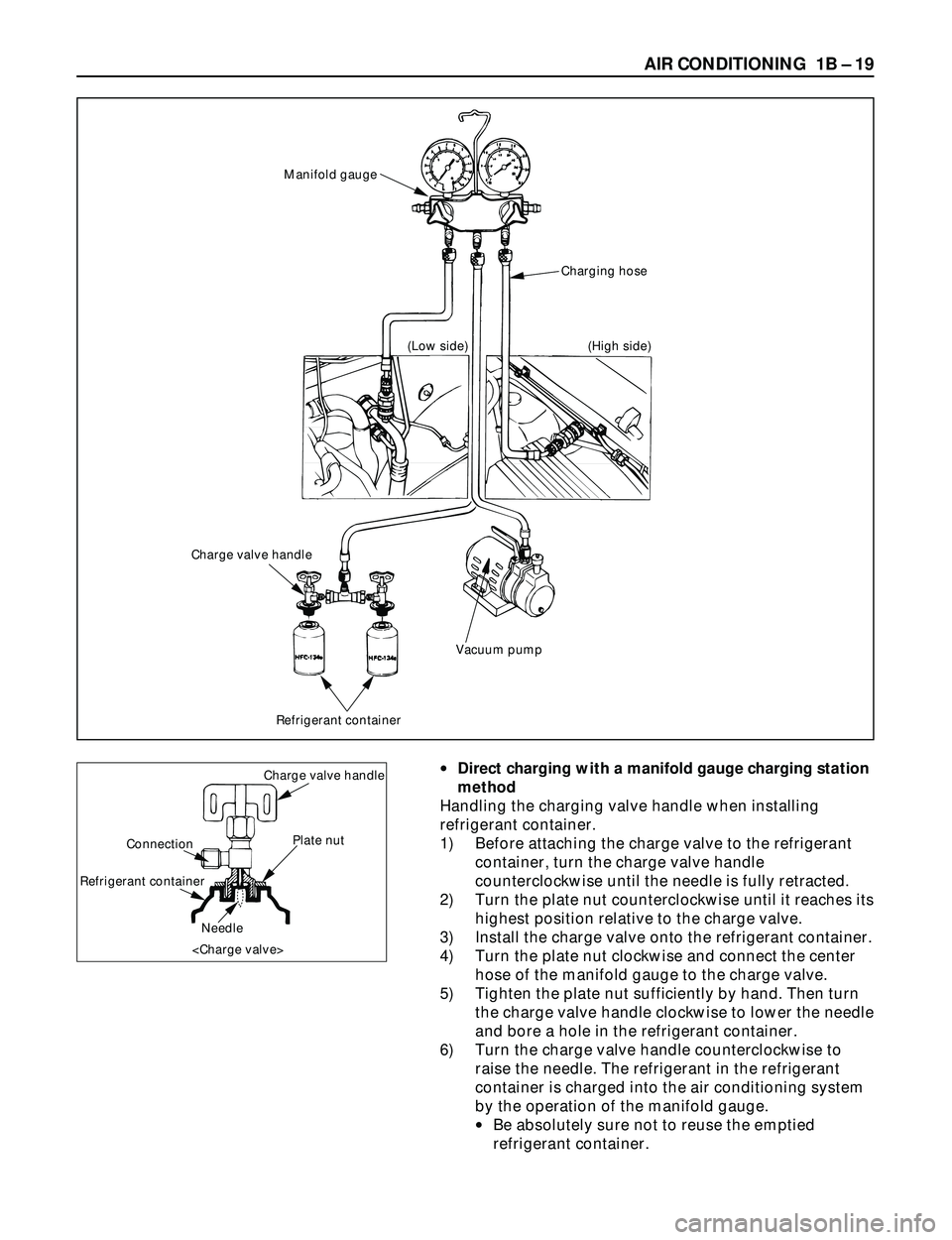
AIR CONDITIONING 1B Ð 19
·Direct charging with a manifold gauge charging station
method
Handling the charging valve handle when installing
refrigerant container.
1) Before attaching the charge valve to the refrigerant
container, turn the charge valve handle
counterclockwise until the needle is fully retracted.
2) Turn the plate nut counterclockwise until it reaches its
highest position relative to the charge valve.
3) Install the charge valve onto the refrigerant container.
4) Turn the plate nut clockwise and connect the center
hose of the manifold gauge to the charge valve.
5) Tighten the plate nut sufficiently by hand. Then turn
the charge valve handle clockwise to lower the needle
and bore a hole in the refrigerant container.
6) Turn the charge valve handle counterclockwise to
raise the needle. The refrigerant in the refrigerant
container is charged into the air conditioning system
by the operation of the manifold gauge.
·Be absolutely sure not to reuse the emptied
refrigerant container.Charge valve handle
Plate nut
Needle Connection
Refrigerant container
Charging hose Manifold gauge
Vacuum pump
Refrigerant container
Charge valve handle
(Low side) (High side)
Page 146 of 3573
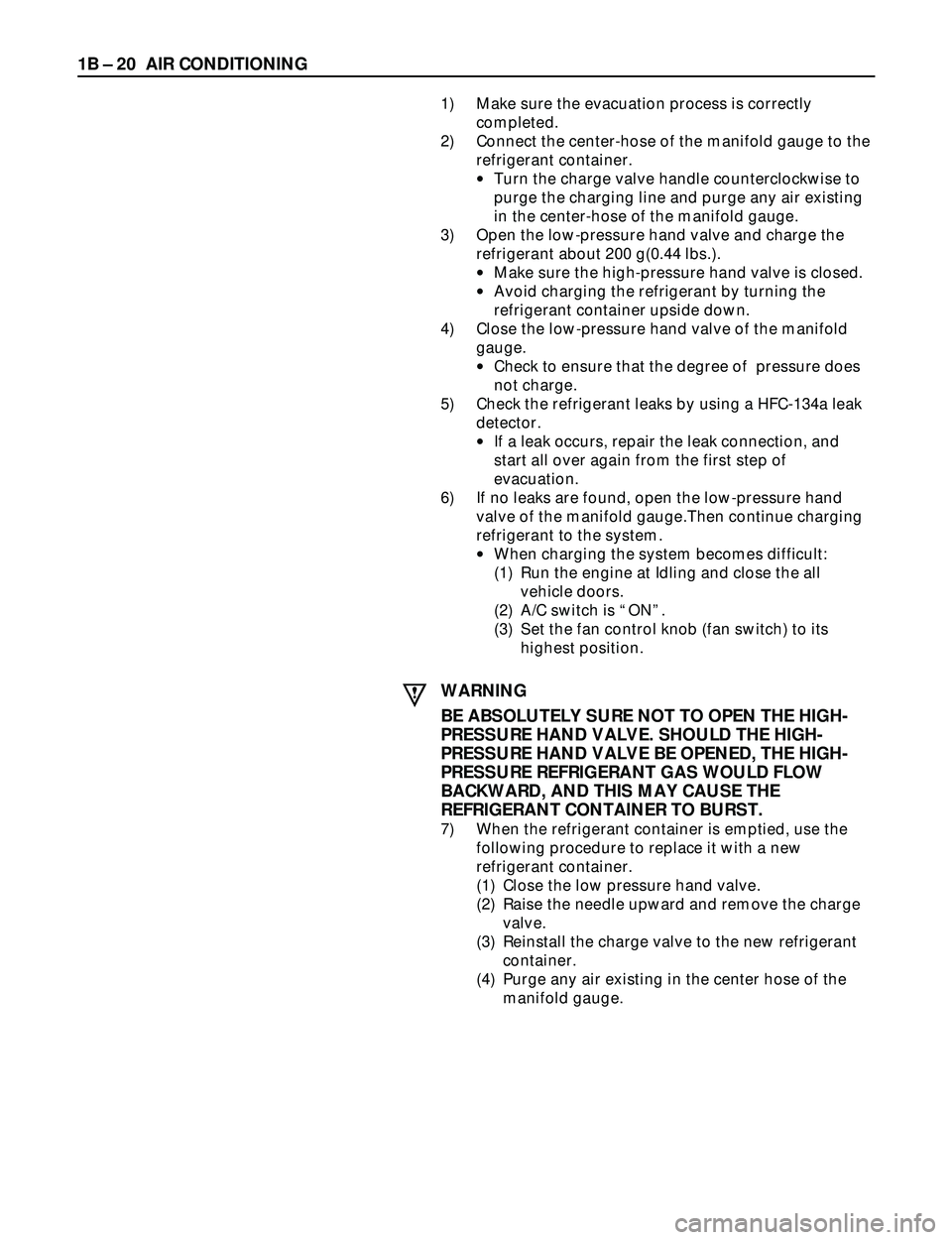
1B Ð 20 AIR CONDITIONING
1) Make sure the evacuation process is correctly
completed.
2) Connect the center-hose of the manifold gauge to the
refrigerant container.
·Turn the charge valve handle counterclockwise to
purge the charging line and purge any air existing
in the center-hose of the manifold gauge.
3) Open the low-pressure hand valve and charge the
refrigerant about 200 g(0.44 lbs.).
·Make sure the high-pressure hand valve is closed.
·Avoid charging the refrigerant by turning the
refrigerant container upside down.
4) Close the low-pressure hand valve of the manifold
gauge.
·Check to ensure that the degree of pressure does
not charge.
5) Check the refrigerant leaks by using a HFC-134a leak
detector.
·If a leak occurs, repair the leak connection, and
start all over again from the first step of
evacuation.
6) If no leaks are found, open the low-pressure hand
valve of the manifold gauge.Then continue charging
refrigerant to the system.
·When charging the system becomes difficult:
(1) Run the engine at Idling and close the all
vehicle doors.
(2) A/C switch is ÒONÓ.
(3) Set the fan control knob (fan switch) to its
highest position.
WARNING
BE ABSOLUTELY SURE NOT TO OPEN THE HIGH-
PRESSURE HAND VALVE. SHOULD THE HIGH-
PRESSURE HAND VALVE BE OPENED, THE HIGH-
PRESSURE REFRIGERANT GAS WOULD FLOW
BACKWARD, AND THIS MAY CAUSE THE
REFRIGERANT CONTAINER TO BURST.
7) When the refrigerant container is emptied, use the
following procedure to replace it with a new
refrigerant container.
(1) Close the low pressure hand valve.
(2) Raise the needle upward and remove the charge
valve.
(3) Reinstall the charge valve to the new refrigerant
container.
(4) Purge any air existing in the center hose of the
manifold gauge.
Page 147 of 3573
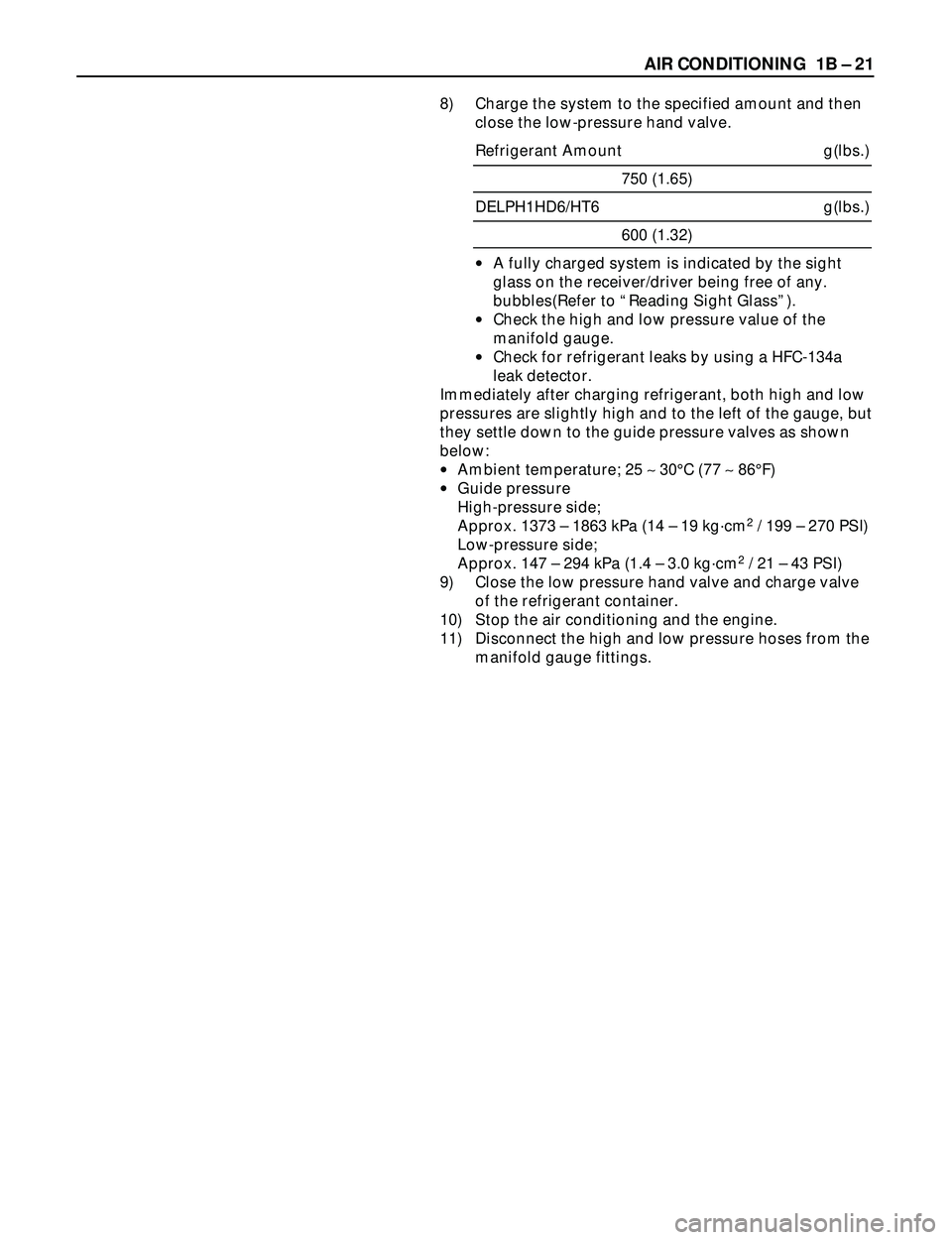
AIR CONDITIONING 1B Ð 21
8) Charge the system to the specified amount and then
close the low-pressure hand valve.
Refrigerant Amount g(lbs.)
750 (1.65)
DELPH1HD6/HT6 g(lbs.)
600 (1.32)
·A fully charged system is indicated by the sight
glass on the receiver/driver being free of any.
bubbles(Refer to ÒReading Sight GlassÓ).
·Check the high and low pressure value of the
manifold gauge.
·Check for refrigerant leaks by using a HFC-134a
leak detector.
Immediately after charging refrigerant, both high and low
pressures are slightly high and to the left of the gauge, but
they settle down to the guide pressure valves as shown
below:
·Ambient temperature; 25 ~30¡C (77 ~86¡F)
·Guide pressure
High-pressure side;
Approx. 1373 Ð 1863 kPa (14 Ð 19 kgácm
2/ 199 Ð 270 PSI)
Low-pressure side;
Approx. 147 Ð 294 kPa (1.4 Ð 3.0 kgácm
2/ 21 Ð 43 PSI)
9) Close the low pressure hand valve and charge valve
of the refrigerant container.
10) Stop the air conditioning and the engine.
11) Disconnect the high and low pressure hoses from the
manifold gauge fittings.
Page 148 of 3573
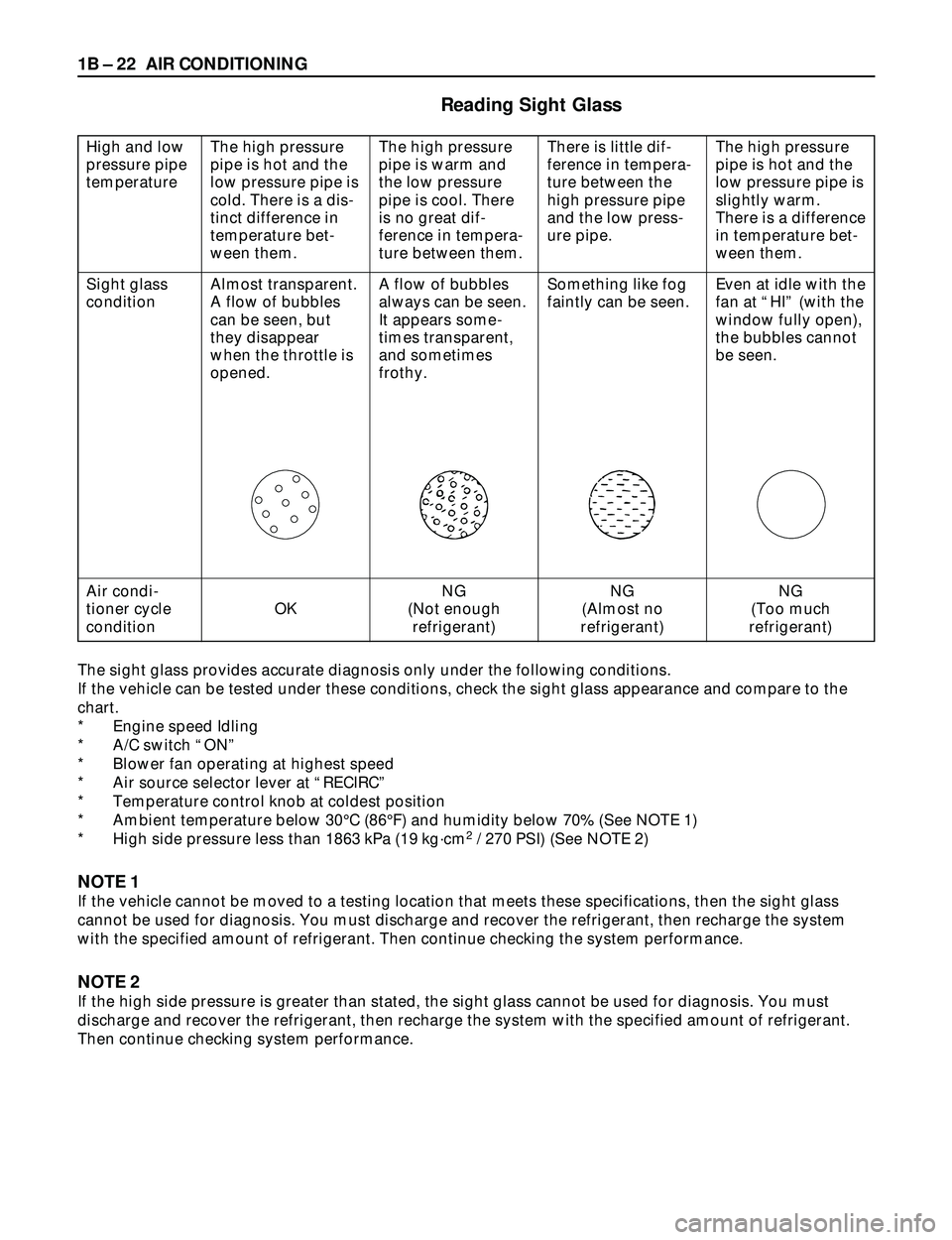
1B Ð 22 AIR CONDITIONING
Almost transparent.
A flow of bubbles
can be seen, but
they disappear
when the throttle is
opened.
The sight glass provides accurate diagnosis only under the following conditions.
If the vehicle can be tested under these conditions, check the sight glass appearance and compare to the
chart.
* Engine speed Idling
* A/C switch ÒONÓ
* Blower fan operating at highest speed
* Air source selector lever at ÒRECIRCÓ
* Temperature control knob at coldest position
* Ambient temperature below 30¡C (86¡F) and humidity below 70% (See NOTE 1)
* High side pressure less than 1863 kPa (19 kgácm
2/ 270 PSI) (See NOTE 2)
NOTE 1
If the vehicle cannot be moved to a testing location that meets these specifications, then the sight glass
cannot be used for diagnosis. You must discharge and recover the refrigerant, then recharge the system
with the specified amount of refrigerant. Then continue checking the system performance.
NOTE 2
If the high side pressure is greater than stated, the sight glass cannot be used for diagnosis. You must
discharge and recover the refrigerant, then recharge the system with the specified amount of refrigerant.
Then continue checking system performance.
Reading Sight Glass
High and low
pressure pipe
temperature
Sight glass
condition
Air condi-
tioner cycle
condition
The high pressure
pipe is hot and the
low pressure pipe is
cold. There is a dis-
tinct difference in
temperature bet-
ween them.
OK
The high pressure
pipe is warm and
the low pressure
pipe is cool. There
is no great dif-
ference in tempera-
ture between them.
A flow of bubbles
always can be seen.
It appears some-
times transparent,
and sometimes
frothy.
NG
(Not enough
refrigerant)
There is little dif-
ference in tempera-
ture between the
high pressure pipe
and the low press-
ure pipe.
Something like fog
faintly can be seen.
NG
(Almost no
refrigerant)
The high pressure
pipe is hot and the
low pressure pipe is
slightly warm.
There is a difference
in temperature bet-
ween them.
Even at idle with the
fan at ÒHIÓ (with the
window fully open),
the bubbles cannot
be seen.
NG
(Too much
refrigerant)
Page 149 of 3573
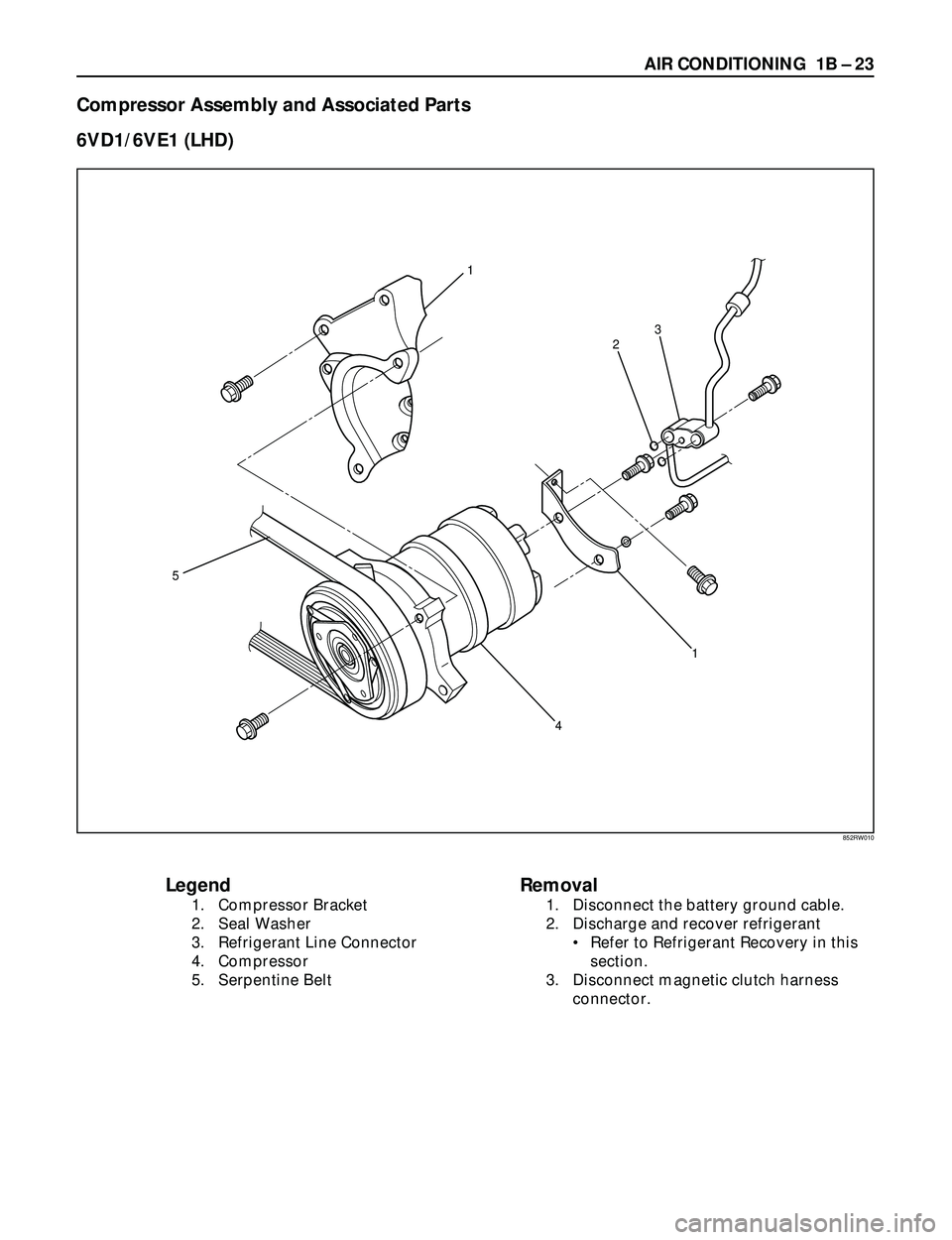
AIR CONDITIONING 1B Ð 23
Legend
1. Compressor Bracket
2. Seal Washer
3. Refrigerant Line Connector
4. Compressor
5. Serpentine Belt
Removal
1. Disconnect the battery ground cable.
2. Discharge and recover refrigerant
¥ Refer to Refrigerant Recovery in this
section.
3. Disconnect magnetic clutch harness
connector.
Compressor Assembly and Associated Parts
6VD1/6VE1 (LHD)
1
5
23
4
1
852RW010
Page 150 of 3573
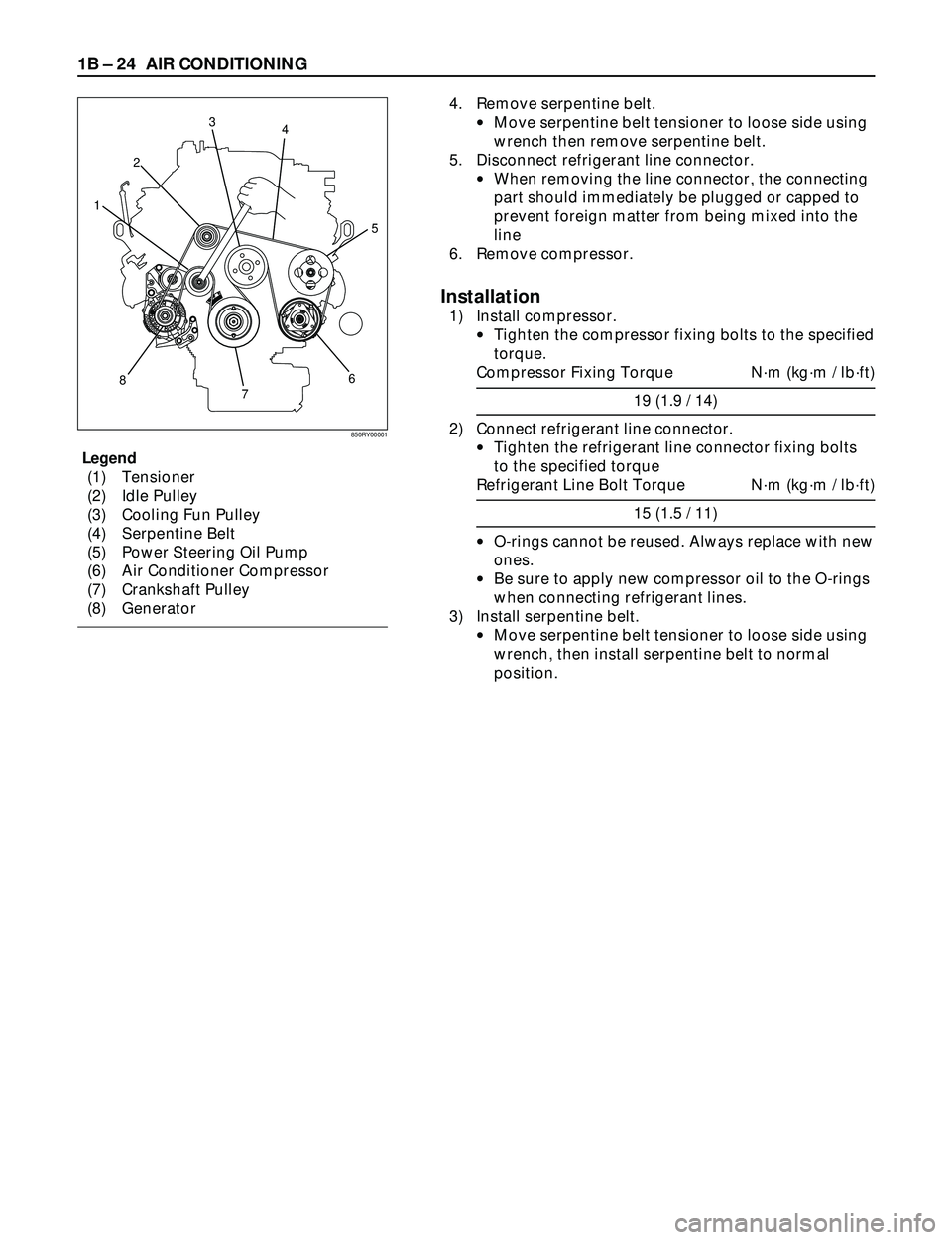
1B Ð 24 AIR CONDITIONING
3
4
2
7 86 1
5
4. Remove serpentine belt.
·Move serpentine belt tensioner to loose side using
wrench then remove serpentine belt.
5. Disconnect refrigerant line connector.
·When removing the line connector, the connecting
part should immediately be plugged or capped to
prevent foreign matter from being mixed into the
line
6. Remove compressor.
Installation
1) Install compressor.
·Tighten the compressor fixing bolts to the specified
torque.
Compressor Fixing Torque Nám (kgám / lbáft)
19 (1.9 / 14)
2) Connect refrigerant line connector.
·Tighten the refrigerant line connector fixing bolts
to the specified torque
Refrigerant Line Bolt Torque Nám (kgám / lbáft)
15 (1.5 / 11)
·O-rings cannot be reused. Always replace with new
ones.
·Be sure to apply new compressor oil to the O-rings
when connecting refrigerant lines.
3) Install serpentine belt.
·Move serpentine belt tensioner to loose side using
wrench, then install serpentine belt to normal
position.
850RY00001
Legend
(1) Tensioner
(2) Idle Pulley
(3) Cooling Fun Pulley
(4) Serpentine Belt
(5) Power Steering Oil Pump
(6) Air Conditioner Compressor
(7) Crankshaft Pulley
(8) Generator
Page 151 of 3573
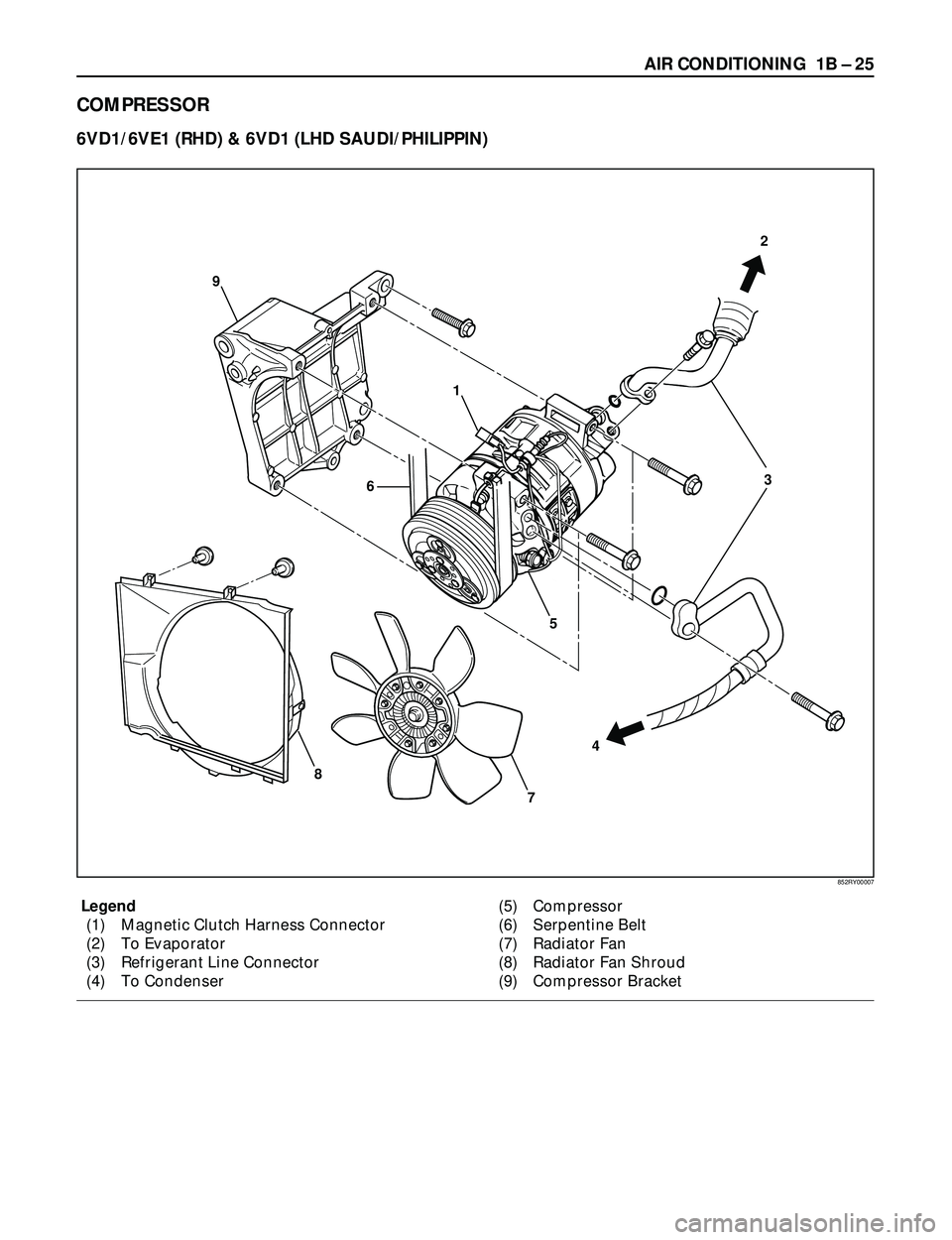
AIR CONDITIONING 1B Ð 25
Legend
(1) Magnetic Clutch Harness Connector
(2) To Evaporator
(3) Refrigerant Line Connector
(4) To Condenser(5) Compressor
(6) Serpentine Belt
(7) Radiator Fan
(8) Radiator Fan Shroud
(9) Compressor Bracket
COMPRESSOR
6VD1/6VE1 (RHD) & 6VD1 (LHD SAUDI/PHILIPPIN)
3
42
5
7
8
9
1
6
852RY00007
Page 152 of 3573
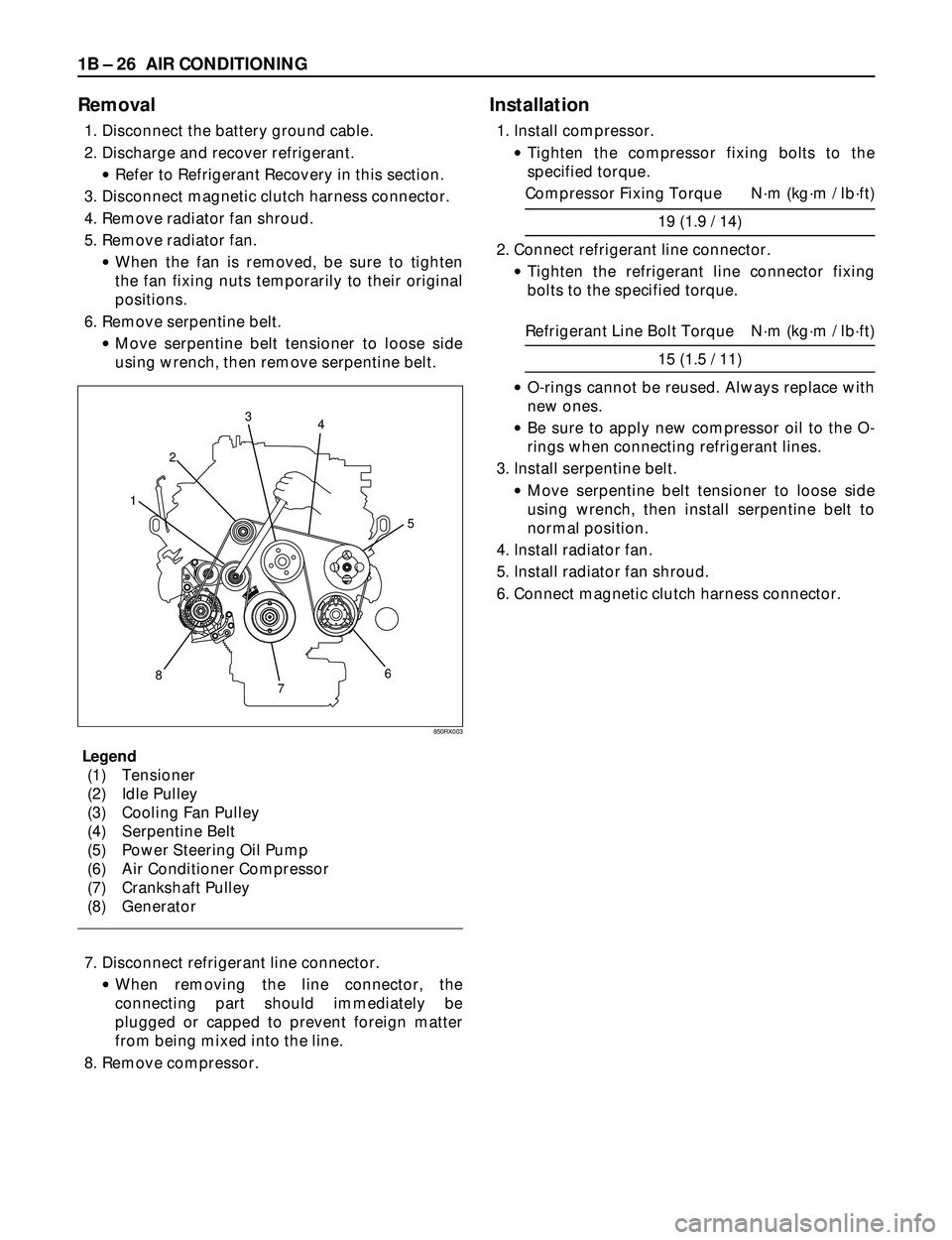
1B Ð 26 AIR CONDITIONING
Removal
1. Disconnect the battery ground cable.
2. Discharge and recover refrigerant.
·Refer to Refrigerant Recovery in this section.
3. Disconnect magnetic clutch harness connector.
4. Remove radiator fan shroud.
5. Remove radiator fan.
·When the fan is removed, be sure to tighten
the fan fixing nuts temporarily to their original
positions.
6. Remove serpentine belt.
·Move serpentine belt tensioner to loose side
using wrench, then remove serpentine belt.
Legend
(1) Tensioner
(2) Idle Pulley
(3) Cooling Fan Pulley
(4) Serpentine Belt
(5) Power Steering Oil Pump
(6) Air Conditioner Compressor
(7) Crankshaft Pulley
(8) Generator
7. Disconnect refrigerant line connector.
·When removing the line connector, the
connecting part should immediately be
plugged or capped to prevent foreign matter
from being mixed into the line.
8. Remove compressor.
Installation
1. Install compressor.
·Tighten the compressor fixing bolts to the
specified torque.
Compressor Fixing Torque Nám (kgám / lbáft)
19 (1.9 / 14)
2. Connect refrigerant line connector.
·Tighten the refrigerant line connector fixing
bolts to the specified torque.
Refrigerant Line Bolt Torque Nám (kgám / lbáft)
15 (1.5 / 11)
·O-rings cannot be reused. Always replace with
new ones.
·Be sure to apply new compressor oil to the O-
rings when connecting refrigerant lines.
3. Install serpentine belt.
·Move serpentine belt tensioner to loose side
using wrench, then install serpentine belt to
normal position.
4. Install radiator fan.
5. Install radiator fan shroud.
6. Connect magnetic clutch harness connector.
3
4
2
7 86 1
5
850RX003
Page 153 of 3573

AIR CONDITIONING 1B Ð 27
871RY00013
Removal Steps
1. Air duct
2. Magnetic clutch harness connector
3. Drive belt
4. Refrigerant line connector
5. Compressor
Installation Steps
To install, follow the removal steps in the
reverse order.
4JG2 ENGINE
Compressor
bracket
2
5
13
4
O-ring
Page 154 of 3573
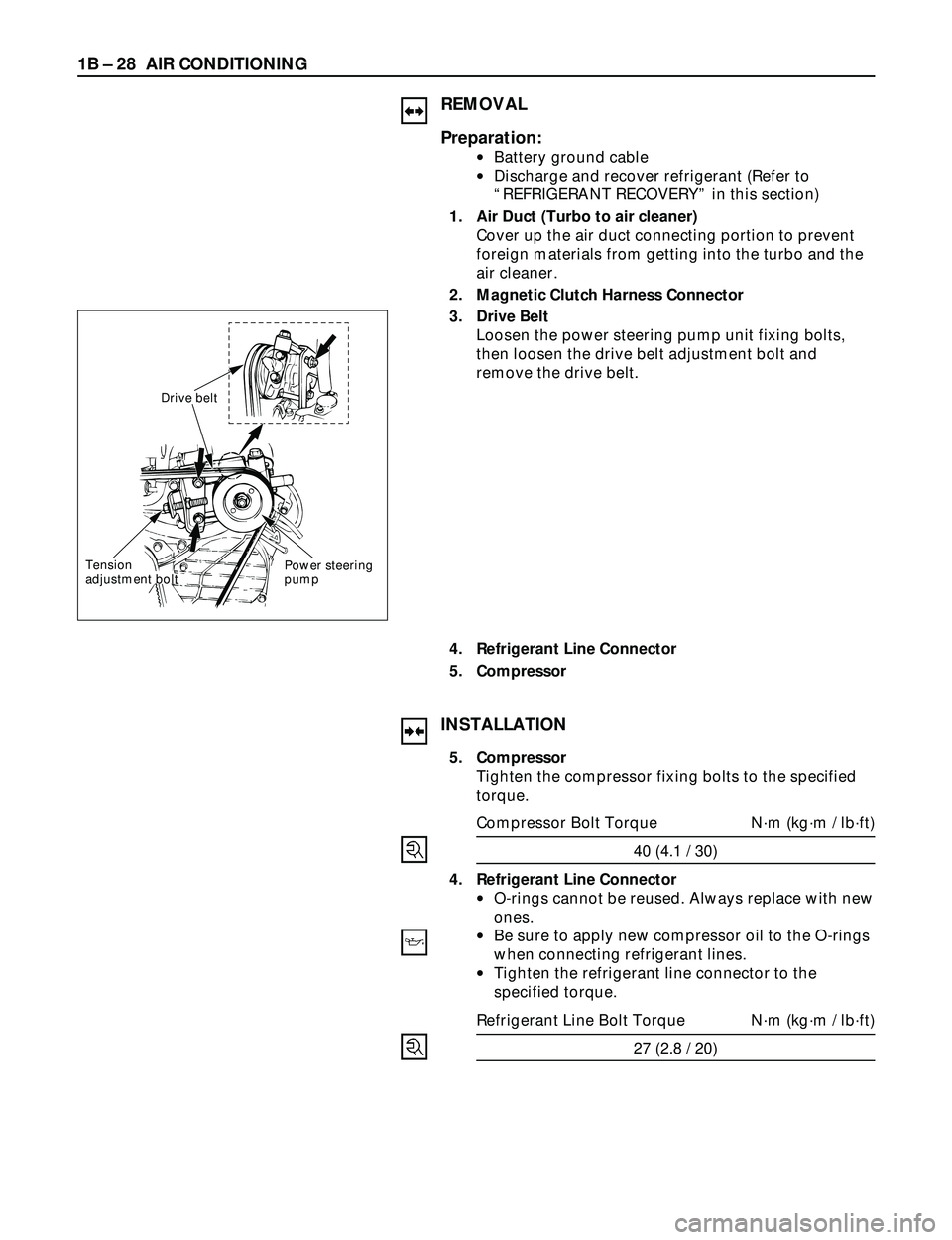
1B Ð 28 AIR CONDITIONING
REMOVAL
Preparation:
·Battery ground cable
·Discharge and recover refrigerant (Refer to
ÒREFRIGERANT RECOVERYÓ in this section)
1. Air Duct (Turbo to air cleaner)
Cover up the air duct connecting portion to prevent
foreign materials from getting into the turbo and the
air cleaner.
2. Magnetic Clutch Harness Connector
3. Drive Belt
Loosen the power steering pump unit fixing bolts,
then loosen the drive belt adjustment bolt and
remove the drive belt.
4. Refrigerant Line Connector
5. Compressor
Drive belt
Power steering
pump Tension
adjustment bolt
INSTALLATION
5. Compressor
Tighten the compressor fixing bolts to the specified
torque.
Compressor Bolt Torque Nám (kgám / lbáft)
40 (4.1 / 30)
4. Refrigerant Line Connector
·O-rings cannot be reused. Always replace with new
ones.
·Be sure to apply new compressor oil to the O-rings
when connecting refrigerant lines.
·Tighten the refrigerant line connector to the
specified torque.
Refrigerant Line Bolt Torque Nám (kgám / lbáft)
27 (2.8 / 20)